#gravitational lensing
Text
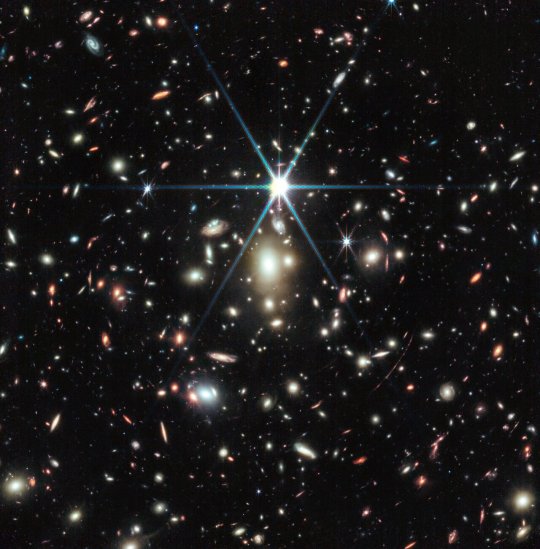
Sunrise Arc
84 notes
·
View notes
Text

A Galaxy Gravitational Lens - December 20th, 1995.
"Sometimes it takes a keen eye to see a good mirage. Around the center of the red galaxy image in the above photograph lie four blue "smudges." Each smudge is actually a different image of the same background quasar. The central galaxy happens to fall directly in the light path of the quasar. Consequently, the huge mass of the galaxy is able to pull separate images of the quasar around it - an effect called gravitational lensing. Hence we see a gravitational mirage! Astronomers have hopes of using light differences between these quasar images to not only "weigh" the central galaxy, but even provide clues about the expansion rate and composition of the Universe."
24 notes
·
View notes
Text
I don't talk about astronomy nearly enough, so let's change that!
One of the most groundbreaking developments in astronomy has been the absolutely mind-blowing work the James Webb Space Telescope has been putting out in a fraction of the time it took the old Hubble Space Telescope to produce similar work. Here are a couple of recent images I find particularly remarkable.
S1 LMC N79 – Dorado

Honestly, this image is just beautiful to look at. It’s even more breathtaking when you consider that this is just one cloud within this star-forming region of the Large Magellanic Cloud, which itself is an irregular galaxy located about 163,000 light-years from Earth. If you live in the Southern Hemisphere and find yourself a suitably dark place, you can gaze up and see this whole other galaxy as a milky blotch in the night sky.
You can read more about this image here.
A gravitationally lensed supernova in MRG-M0138 – Cetus

It's pretty wild seeing the immense force of gravity contained within these galactic clusters warp distant points of light in these visually striking ways. Each arc is a galaxy far beyond the cluster itself that allow us to peer further back in time. Sometimes these warped images mirror themselves on the complete opposite side of the cluster, like ripples on a pond. In the case of this distant supernova, the light emanating from that cataclysmic event is being reflected in such a way that it's reappearing further down the length of the arc, making it seem as though there are two supernovae happening when in fact they are the same.
You can read more about this image here.
#astronomy#james webb space telescope#star cluster#stellar nursery#molecular cloud#supernova#gravitational lensing#galaxies#large magellanic cloud
16 notes
·
View notes
Link
Astronomers have just discovered what may be the largest black hole known to date.
The giant black hole has a mass of 30 billion suns and sits at the center of a galaxy located hundreds of millions of light-years from Earth. Astronomers call the cosmic monster an ultramassive black hole, as opposed to the usual galactic supermassive black holes that weigh anywhere between a few million to a few billion solar masses.
Astronomers discovered the black hole during observations of a galaxy located farther away from Earth than the one centered around the monster black hole, while using the gravity of the foreground galaxy to magnify the background object. This effect, known as gravitational lensing, is a result of gravity bending the light around extremely massive objects. Serving as nature's own telescope, gravitational lensing frequently helps astronomers to increase the magnification of objects too distant to be properly visible to human-made telescopes.
"This particular black hole, which is roughly 30 billion times the mass of our sun, is one of the biggest ever detected and on the upper limit of how large we believe black holes can theoretically become, so it is an extremely exciting discovery," James Nightingale, an astrophysicist at Durham University in the U.K. and lead author of the new study, said in a statement.
Continue Reading
140 notes
·
View notes
Text
The first JWST image is creating quite a buzz around gravitational lensing because of the sheer amount of it in the image. Gravitational lensing makes galaxies appear warped like these:


Because spacetime curves around a massive body, light bends when it's near enough a massive object, allowing us to see very distant galaxies behind the cluster we're looking at.

Here is some recommended reading on it if you wanna learn more:
#nasa#space#astronomy#science#astrophotography#astrophysics#gravitational lensing#jwst#james webb space telescope#physics#einstein#spacetime#ok I have a bachelor thesis to write so I will not be getting into this enough to explain it in depth#so I can just share some resources on this#but maybe next week#my post#rename jwst#RenameJWST
345 notes
·
View notes
Text
A few days ago I watched "Einstein and Eddington", in the midst of my Tennaissance. I'm glad I discovered this film, it's really beautiful and definitely my kind.
Well, first of all I jokingly asked myself if David will ever play a non-queer charachter (actually I've already seen Broadchurch), even though I love him also for that ♡
But most importantly, I've started doing some research about sir Arthur Eddington. I did rember coming across his name during the astronomy course, but I realized that he is not as famous as he sould be, considering the discoveries he made. Thanks to his studies he helped confirm the theory of relativity, to name one.
And then I found a poem written in his memory, so touching and beautiful. I searched the author and...it's been written by Neil Gaiman! I leave here the text. There are actually two of them, the second one about his personal life and the rumors according to which he had a relationship with another man (I say rumors because I couldn't find evidences, even though their social and religious context would have make it difficult even talk about the situation, maybe hence the lack of proof):
IN TRANSIT (for Arthur Eddington)
by Neil Gaiman
1.
To find the many in the one
he sweated under foreign skies
to see the stars behind the sun.
So space and time were now undone
reality was undisguised.
We found the many in the one.
There is no photograph, not one,
that shows the mind behind the eyes.
He saw the stars behind the sun.
Not with a sword, or knife, or gun,
a simple picture severed ties.
He found the many in the one.
Light bends around us. So we run,
as gravity reclassifies
the stars we saw behind the sun.
To see the world beyond the skies,
to know the mind behind the eyes,
To find the many in the one
he showed us stars behind the sun.
2.
Unfucked, or anyway retiring,
in the awkward sense. Retirement will never be an option.
The gruff gentleman with the cap who understands
what the numbers mean
remembers a bicycle ride when he was younger.
The smoke of the cigarettes he does not smoke kicks at his lungs
mixing with the buzz of the booze he doesn’t ever drink
a convivial pint after the ride into the country gave him such a thirst.
And afterwards they lay on their back in the stubble
staring up at the stars. Together. All the stars
Countable as the words in a Bible,
countable as the hairs on his friend’s head,
all accountable, and that is why they never truly touched.
The shadow of prison or disgrace perhaps moving between them
like the shadow of an eclipse.
And, in another life, at another time,
to see the stars behind the sun,
he takes his photographs
fighting the cloud cover. Becoming
the thing that happened in Principe.
when he proved that the German was right,
that light had weight,
half a year after the Armistice.
A populariser, but not courting popularity.
Somewhen a boy is counting stars.
Somewhen a man is photographing light.
Somewhen his finger strokes the stubble on another’s cheek,
and for a moment everything is relative.
You can also find a clip of him reading the poem:
#neil gaiman#einstein and eddington#arthur eddington#david tennant#david tennaissance#theory of relativity#gravity#more like mavity#gravitational lensing#physics#eclipse#film#poems on tumblr#poems and poetry#Universe#planets#in transit#doctor who#good omens#good omens 2#broadchurch#casanova
14 notes
·
View notes
Text
Webb's Discovery: Colors of Earendel, Distant Star
James Webb Telescope discovers Earendel, the most distant star ever detected, revealing fascinating colors and potential companion.
his image from NASA’s James Webb Space Telescope of a massive galaxy cluster called WHL0137-08 contains the most strongly magnified galaxy known in the universe’s first billion years: the Sunrise Arc, and within that galaxy, the most distant star ever detected.The star, nicknamed Earendel, was first discovered by the Hubble Space Telescope. Follow-up observations using Webb’s NIRCam…
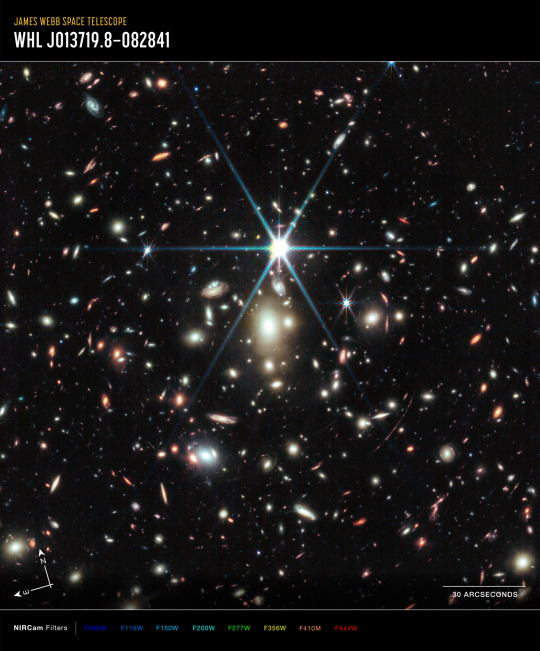
View On WordPress
#Astronomical Breakthrough#Distant Star#Gravitational Lensing#James Webb Space Telescope#Sunrise Arc Galaxy#Webb Reveals Colors of Earendel
22 notes
·
View notes
Text
Black Hole and Cosmic Lensing
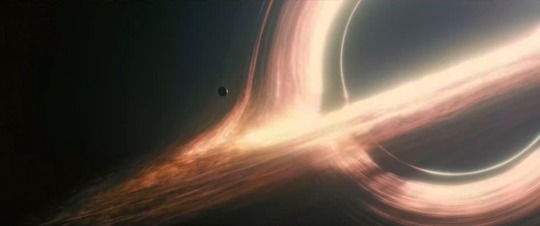
Once in my early youth, I watched a sci-fi movie about space travel that supposedly featured a black hole. It resembled a galaxy, which I found quite amusing—how can you see a black hole if no light can escape from it? Much later, I realized that although the depiction in the movie wasn't accurate, and yes, we certainly can't see the black hole itself, there are still many fascinating phenomena around it that can be observed. So, what exactly can we observe?
First, imagine Saturn with its majestic rings. Then, imagine this Saturn turning black, becoming invisible—and you'll get the picture. There are luminous rings rotating around something that, in reality, we cannot see. But it's definitely there. These rings, or more accurately, the matter drawn in by the black hole, spin at tremendous speeds and are located in the equatorial plane—just as in any galaxy formed around any massive celestial body. Unlike the tranquil, icy rings leisurely circling our native gas giant Saturn, this matter is accelerated to nearly the speed of light. It may be dense and heated near this celestial body and becomes more sparse and slower farther away. Another way to visualize it is like a whirlpool, only much faster.
But in the picture (below), it doesn't quite resemble rings. It looks more like a strange, faceless smiley wearing a hat, reminiscent of what some viewers might have seen in the movie 'Interstellar.' The reason is that space is distorted so much, so what lies behind this celestial body appears partially above and partially below it. The image seems almost turned inside out. Thus, the depiction is akin to Saturn's rings, if they were reflected in a curved mirror, or more accurately, viewed through a powerful lens.
I highly recommend clicking on the link on the video (below) to see it in action - it's absolutely spectacular!
youtube
Also, if you haven't seen the movie 'Interstellar,' I strongly suggest watching it. A group of scientists, including Kip Thorne, participated in its production. Thorne even wrote a book titled 'The Science of Interstellar' with scientific explanations. He explains how the film crew aimed to create images and visualizations as close as possible to what is actually known in science, or at least to use real scientific hypotheses. For the visualization of the black hole, they employed real scientific models, and the visuals were based on the latest scientific understanding. This approach was validated by the recent actual photograph of a black hole.

In this visualization (below), it’s easy to observe dynamically why the rings around a black hole take on such a peculiar shape. The image displays a computer model showing how a black hole would appear if it passed in front of a distant galaxy. Note that the galaxy itself remains unaffected; it is far away, and nothing is happening to it. It's just the image of the galaxy that changes - it resembles what you would see if you took a thick, convex lens and moved it across the backdrop of that same galaxy or a simple geometric pattern. If you have such a lens or a glass sphere, try this experiment. It’s a straightforward way to help understand this phenomenon

So, the biggest difficulty in understanding is that the picture appears static to us. As soon as you see it in motion, there's a moment of recognition of the phenomenon, and then it's no longer a problem to understand why you see rings both around the shadow of the black hole and above and below it.
Furthermore, the ability to view images dynamically also facilitates the discovery of new black holes. When astronomers notice that an entire sector of a previously familiar scene begins behaving strangely — with stars moving erratically or stretching into curved lines, and the image becoming blurred — it strongly indicates the presence of an invisible object traveling between us and this background scene, distorting the image. But we'll discuss this in more detail next time. Stay tuned!
#space#universe#physics#black holes#cosmos#science#astronomy#gravitational lensing#visualization#interstellar#Youtube
6 notes
·
View notes
Text

#Metonic#saros#sidereal astrology#sidereal sagittarius#gravity#anti gravity#gravity falls#gravity rush#defying gravity#gravitational waves#gravitational lensing#gravitational force#dark matter#mass effect#massage#dark energy#gravity circuit#black holes#black hole#equation
4 notes
·
View notes
Text
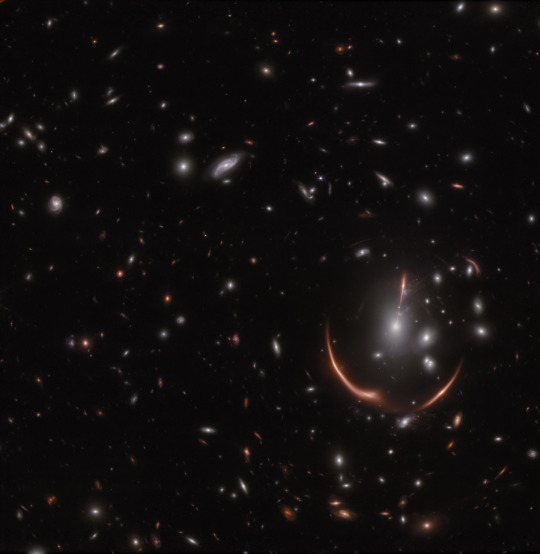
Gravitationally lensed supernova as seen by NASA’s James Webb Space Telescope
#nasa#webb#jwt#james webb space telescope#jwst#supernova#galaxy#stars#gravitational lensing#gravity#space#physics#universe#general relativity#quantum mechanics#benimpost
3 notes
·
View notes
Text
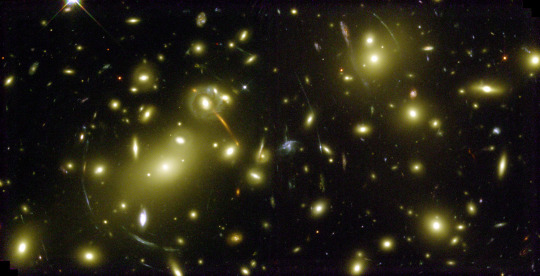
The cluster is so massive that its enormous gravitational field deflects light rays passing through it, much as an optical lens bends light to form an image. This phenomenon, called gravitational lensing, magnifies, brightens, and distorts images from faraway objects. The cluster's magnifying powers provides a powerful "zoom lens" for viewing distant galaxies that could not normally be observed with the largest telescopes. (January 11, 2000)
#krakenmare#astronomy#astrophotography#solar system#nasa#outer space#thank you nasa#space#gravitational lensing
3 notes
·
View notes
Text
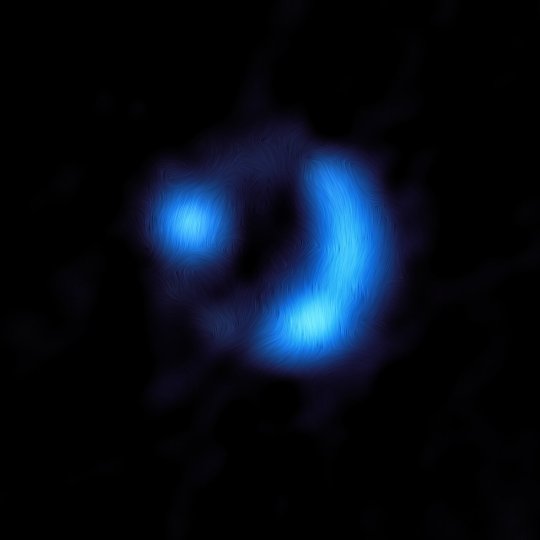
Early Galactic Magnetic Field
65 notes
·
View notes
Text

Well played, Pokémon
#gaming#pokemon#semiotics win#Pokémon sv#professor toro#professor sada#light spectrum#infra red#ultra violet#gravitational lensing
9 notes
·
View notes
Text
Gravitational lensing has to be one of the most visually striking phenomena in astronomy
Gravitational lensing is a phenomenon where a massive object bend the light of a distant source as it approaches the observer. Most often this takes the form of enormous galaxy clusters bending the light of even more distant galaxies into warped images of their true selves. They typically follow an arc around the massive object in the foreground like ripples in a pond.
Here's a few of my favourite gravitational lensing events.
Abel 1689 – Virgo
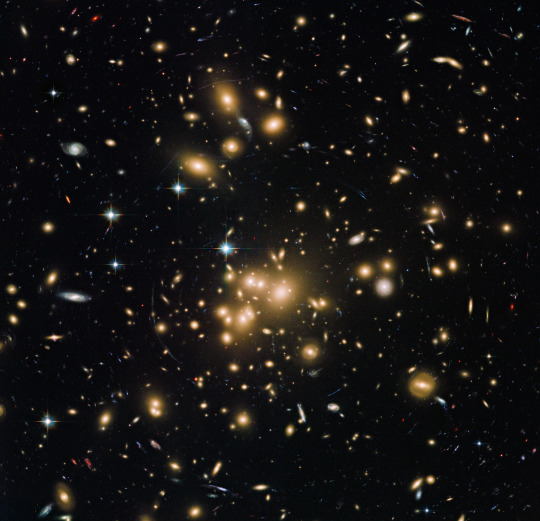
Abel 1689 is a one of the largest galaxy clusters in the known universe. It's located about 2.459 billion light-years away in constellation Virgo. Not only is this image visually beautiful, but the sheer number of gravitationally lensed galaxies across the entire image is just mind-blowing.
In 2008, one of the lensed galaxies, A1689-zD1, became known as the most distant galaxy from Earth based on a photometric redshift. 2008 also happens to be the same year the astronomy bug really bit me and it became one of my life-long passions.
You can find the original image file here.
PSZ1 G311.65-18.48 – Apus
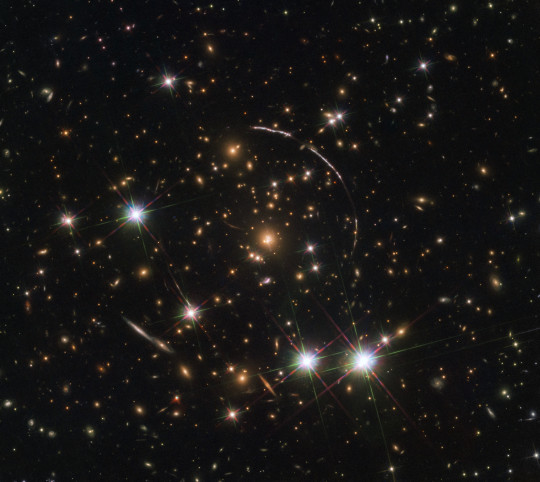
PSZ1 G311.65-18.48 is a massive galaxy cluster located 4.6 billion light-years away in the constellation Apus. What's especially remarkable about this image is that it features a bright galaxy that's been lensed 12 separate times along four arcs. Three of these arcs are visible to the upper right of the cluster, while a fainter fourth arc is partially obscured by a bright foreground star to the bottom left of the cluster. This galaxy is almost 12 billion light-years away from Earth, which given its title as the brightest gravitationally lensed galaxy is quite a remarkable feat.
You can find the original image file here.
MACS J0416.1-2403 – Eridanus

MACS J0416.1-2403 is another massive galaxy cluster located about 4 billion light years away in the constellation. Just…look at all those arcs. Across the entire image you can find countless lensed galaxies. The galaxy cluster itself has an interesting structure, appearing elongated along an arc through the centre of the image frame.
This galaxy cluster happened to have lensed a galaxy that existed about 400 million years after the Big Bang, or about 13.8 billion years ago. At the time of publication, this galaxy was the earliest, most distant object to have ever been observed. It was given the name Tayna, which means "first-born" in the Aymara language indigenous to Chile and Argentina.
You can read more about this cluster and find the original image file here.
MACS J1149+2223 – Leo
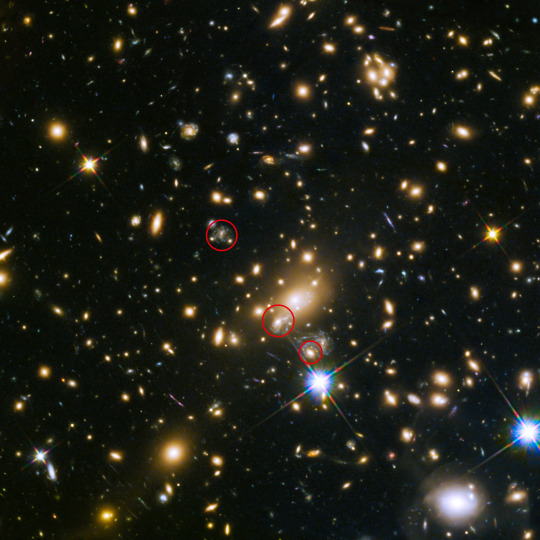
This image is a great example of how gravitational lensing obscures and reveals distant objects depending on our exact position and timing. The lowermost circle shows MACS J1149+2223, a galaxy cluster in the constellation Leo that lensed the Refsdal Supernova to produce four images. This is how the supernova was discovered on 11 November 2014.
The middle circle shows the predicted position of the reappearing supernova in late 2015 or early 2016. It reappeared as expected on 11 December 2015 and was imaged by Hubble.
The uppermost circle shows the position of the supernova as it could have been seen in 1995, but was not actually observed. The supernova may have also appeared elsewhere in the image about 40 to 50 years prior, between 1964 and 1974. Imagine if we had the technology and foresight to observe it then.
You can find the original image here.
3 notes
·
View notes
Photo
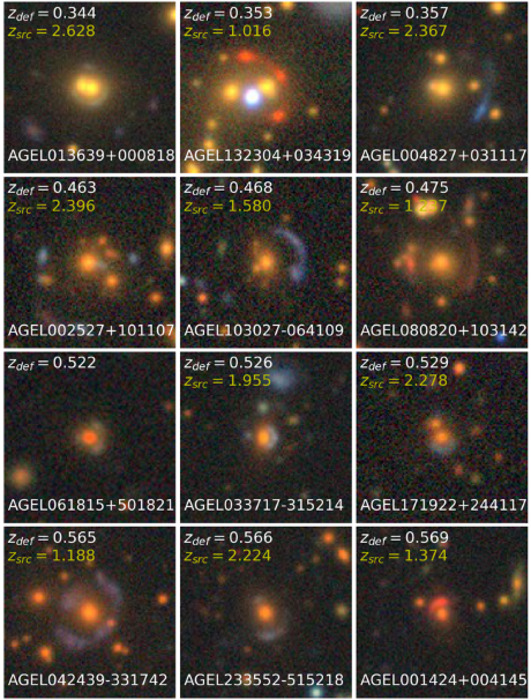
Dozens of newly discovered gravitational lenses could reveal ancient galaxies and the nature of dark matter Earlier this year a machine learning algorithm identified up to 5,000 potential gravitational lenses that could transform our ability to chart the evolution of galaxies since the Big Bang. Now astronomer Kim-Vy Tran from ASTRO 3D and UNSW Sydney and colleagues have assessed 77 of the lenses using the Keck Observatory in Hawai’i and Very Large Telescope in Chile. She and her international team confirmed that 68 out of the 77 are strong gravitational lenses spanning vast cosmic distances. This success rate of 88 per cent suggests that the algorithm is reliable and that we could have thousands of new gravitational lenses. To date, gravitational lenses have been hard to find and only about a hundred are routinely used. Kim-Vy Tran’s paper published today in the Astronomical Journal presents spectroscopic confirmation of strong gravitational lenses previously identified using Convolutional Neural Networks, developed by data scientist Dr Colin Jacobs at ASTRO 3D and Swinburne University. The work is part of the ASTRO 3D Galaxy Evolution with Lenses (AGEL) survey. “Our spectroscopy allowed us to map a 3D picture of the gravitational lenses to show they are genuine and not merely chance superposition,” says corresponding author Dr. Tran from the ARC Centre of Excellence for All Sky Astrophysics in 3-Dimensions (ASTRO3D) and the University of NSW (UNSW). “Our goal with AGEL is to spectroscopically confirm around 100 strong gravitational lenses that can be observed from both the Northern and Southern hemispheres throughout the year,” she says. The paper is the result of a collaboration spanning the globe with researchers from Australia, the United States, the United Kingdom, and Chile. The work was made possible by the development of the algorithm to look for certain digital signatures. “With that we could identify many thousands of lenses compared to just a few handfuls,” says Dr. Tran. Gravitational lensing was first identified as a phenomenon by Einstein who predicted that light bends around massive objects in space in the same way that light bends going through a lens. In doing so, it greatly magnifies images of galaxies that we would not otherwise be able to see. While it has been used by astronomers to observe far away galaxies for a long time, finding these cosmic magnifying glasses in the first place has been hit and miss. “These lenses are very small so if you have fuzzy images, you're not going to really be able to detect them,” says Dr. Tran. While these lenses let us see objects that are millions of light years away more clearly, it should also let us ‘see’ invisible dark matter that makes up most of the Universe. “We know that most of the mass is dark,” says Dr. Tran. “We know that mass is bending light and so if we can measure how much light is bent, we can then infer how much mass must be there.” Having many more gravitational lenses at various distances will also give us a more complete image of the timeline going back almost to the Big Bang. “The more magnifying glasses you have, the better chance you can try to survey these more distant objects. Hopefully, we can better measure the demographics of very young galaxies,” says Dr. Tran. “Then somewhere between those really early first galaxies and us there's a whole lot of evolution that's happening, with tiny star forming regions that convert pristine gas into the first stars to the sun, the Milky Way. “And so with these lenses at different distances, we can look at different points in the cosmic timeline to track essentially how things change over time, between the very first galaxies and now.” Dr Tran’s team spanned the globe, with each group providing different expertise. “Being able to collaborate with people, at different universities, has been so crucial, both for setting the project up in the first place, and now continuing with all of the follow-up observations,” she says. Professor Stuart Wyithe of the University of Melbourne and Director of the ARC Centre of Excellence for All Sky Astrophysics in 3 Dimensions (Astro 3D) says each gravitational lens is unique and tells us something new. “Apart from being beautiful objects, gravitational lenses provide a window to studying how mass is distributed in very distant galaxies that are not observable via other techniques. By introducing ways to use these new large data sets of the sky to search for many new gravitational lenses, the team opens up the opportunity to see how galaxies get their mass,” he says. Professor Karl Glazebrook of Swinburne University, and Dr Tran’s Co-Science Lead on the paper, paid tribute to the work that had gone before. “This algorithm was pioneered by Dr Colin Jacobs at Swinburne. He sifted through tens of millions of galaxy images to prune the sample down to 5,000. Never did we dream that the success rate would be so high,” he says. “Now we are getting images of these lenses with the Hubble Space Telescope, they range from jaw-droopingly beautiful to extremely strange images that will take us considerable effort to figure out.” Associate Professor Tucker Jones of UC Davis, another co-science lead on the paper, described the new sample as “a giant step forward in learning how galaxies form over the history of the Universe”. “Normally these early galaxies look like small fuzzy blobs, but the lensing magnification allows us to see their structure with much better resolution. They are ideal targets for our most powerful telescopes to give us the best possible view of the early universe,” he says. “Thanks to the lensing effect we can learn what these primitive galaxies look like, what they are made of, and how they interact with their surroundings.” The study was conducted in collaboration with researchers from the University of New South Wales, Swinburne University of Technology, Australian National University, Curtin University, and the University of Queensland in Australia, the University of California, Davis, in the US, the University of Portsmouth, in the UK, and University of Chile. The ARC Centre of Excellence for All Sky Astrophysics in 3 Dimensions (ASTRO 3D) is a $40m Research Centre of Excellence funded by the Australian Research Council (ARC) and six collaborating Australian universities - The Australian National University, The University of Sydney, The University of Melbourne, Swinburne University of Technology, The University of Western Australia, and Curtin University. IMAGE....Pictures of gravitational lenses from the AGEL survey. The pictures are centred on the foreground galaxy and include the object name. Each panel includes the confirmed distance to the foreground galaxy (zdef) and distant background galaxy (zsrc). CREDIT Kim-Vy H. Tran et al, 2022 (ENTER DOI)
5 notes
·
View notes
Text

Credit: ESA/Hubble & NASA, J. Rigby
This intriguing observation from the NASA/ESA Hubble Space Telescope shows a gravitationally lensed galaxy with the long-winded identification SGAS J143845+145407. Gravitational lensing has resulted in a mirror image of the galaxy at the centre of this image, creating a captivating centrepiece.
#nasa#esa#space#astronomy#science#astrophotography#physics#astrophysics#gravitational lensing#universe#cosmos#galaxy#stars#planet#planets#I'm absolutely SOBBING about how beautiful this is!!!!!!#LOOK AT THAT LENSING#stunning. absolutely stunning!!!#😍😍😍#my post#hubble space telescope#hubble
16 notes
·
View notes